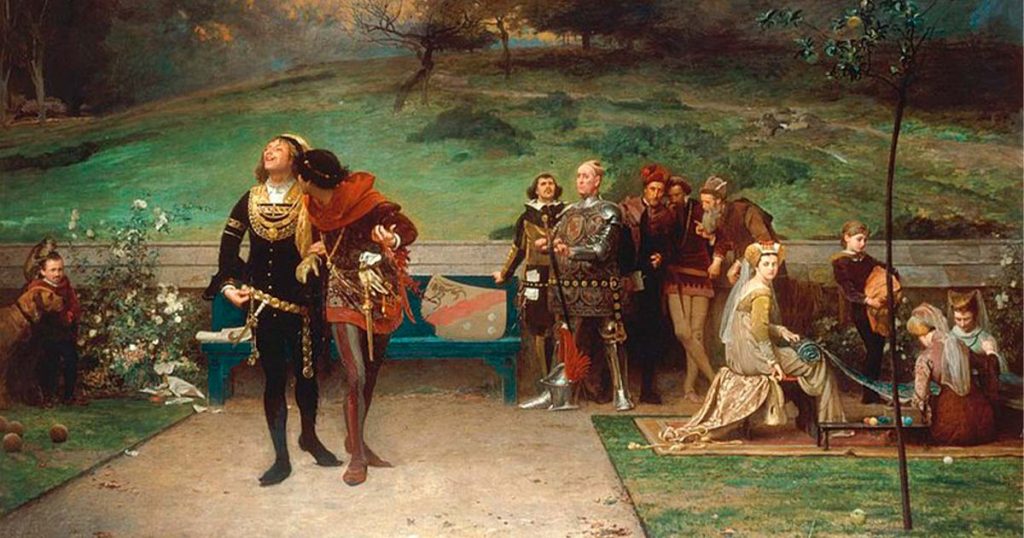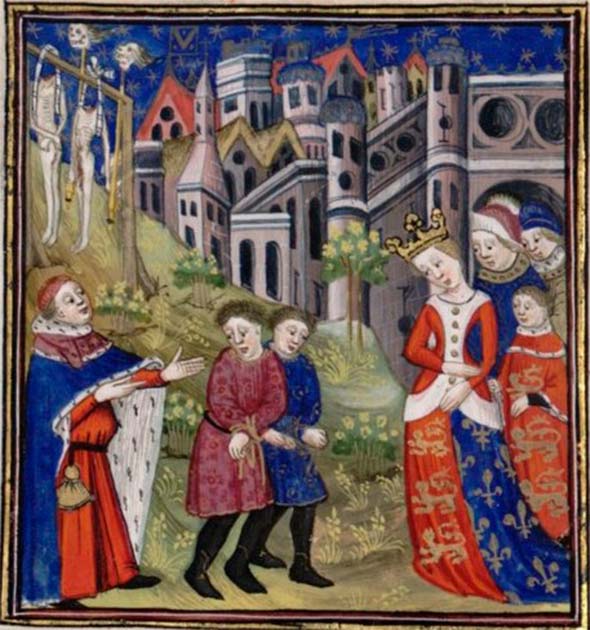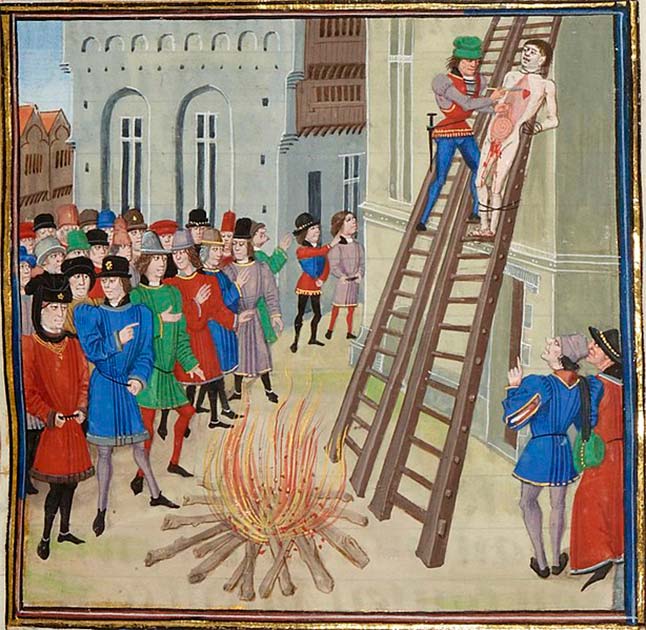In the early 14th century, England was rocked by a scandal that would shake the very foundations of the monarchy. At the center of it all was a man named Hugh Despenser the Younger, a notorious favorite of King Edward II.
Despenser’s rise to power was swift and ruthless, but his fall would be even more spectacular. Accused of everything from sodomy and piracy to treason, Despenser became the focal point of a rebellion that ultimately led to the downfall of Edward II himself.
This is the story of a man whose ambition and thirst for power proved to be his undoing, and the events that shaped one of the most turbulent periods in English history.
The Rise of Hugh Despenser the Younger
Hugh Despenser was born around 1287 AD to Hugh le Despenser, Earl of Winchester (known as Despenser the Elder), and his wife, Isabella De Beauchamp. His parents both hailed from two of England’s most powerful noble families and Hugh was fated from an early age to become a rich and powerful man.
Hugh’s rise to prominence really began in 1306 when he was knighted at the Feast of the Swans (held by King Edward I) alongside Prince Edward (who would later become Edward II). That same year he married Eleanor de Clare who just so happened to be the daughter of a powerful noble, Gilbert de Clare, and Joan of Acre. Why was this important?

Because Joan of Acre was the granddaughter of King Edward I, who owed Despenser the elder 2,000 marks. This was a not inconsiderable sum but the marriage settled the debt. The Dispensers had bought their way into the royal family.
Even better for the younger Hugh, his wife’s brother, Gilbert, died in 1314 fighting the Scottish at the Battle of Bannockburn. This meant she moved up the inheritance food chain, and the couple inherited major estates across England. In no time at all Hugh had gone from a landless knight living off of his parents to one of the wealthiest men in England with close ties to the royal family.
Getting Close to the New King
After King Edward II was crowned in 1307 Hugh wasted little time in cozying up to the king, whose niece he just so happened to be married to. By 1318 he had become a royal chamberlain, meaning he was officially part of the royal court.
He used his new position to maneuver his way into the fickle king’s affections, succeeding in displacing the king’s old favorite, Roger d’ Amory. He may have been the king’s favorite, but the barons hated him.
- Eight English Rulers Who Came to a Sticky End
- Baron Gilles de Rais, History’s Earliest Serial Killer?
Hugh’s greed was allowed to run unchecked by the king, and he took various castles throughout the kingdom including Hanley Castle in Worcestershire, Odiham Castle in Hampshire, and Bristol Castle. The king even gave him Wallingford Castle in Berkshire, which he had previously given to his wife, Queen Isabella of France for life. She was not pleased.
Hugh’s unchecked ambition meant that by 1321 everyone but the King despised him. His two biggest enemies, however, were arguably Queen Isabella and Roger Mortimer (whose family had an ongoing feud with the Despensers). It was these two who brought Despenser’s schemes to an end.
In 1321 Queen Isabella had had enough and convinced the barons to move against King Edward. Their first move was having his closest allies, the Despensers, exiled.
The victory was short-lived though and by early 1322 the Despensers were back. With the aid of the powerful Despensers Edward then managed to crush the fledgling rebellion, which had been led by Hugh’s old nemesis. Roger Mortimer.
What followed was a year during which Despenser essentially got to do (and take) whatever he liked. He was reinstated as the King’s favorite, and the opposition was powerless since their leader, Mortimer, had surrendered.
But it wouldn’t last for long. The following year Mortimer escaped prison and fled to France where he began plotting a new rebellion. In 1326 Isabella was sent to France by Edward to negotiate between her husband and the French king. Isabella had other plans.
Instead of doing what she had been sent to, Isabella met with Mortimer and the two began planning an invasion of England. The plan went into action in September of 1326.
With only a force of around 1,500 mercenaries, Mortimer led an attack on England. The force should have been easily crushed. But Edward II relied on the nobility for his military might. A nobility who was sick to death of the Despensers and their relationship with the King. Rather than fending off the invasion force, the nobility joined it.

With so few allies the Despensers and Edward fled to the West, taking much of the King’s treasury with them. Their escape was unsuccessful. The King and the younger Hugh Despenser were captured near Neath (a town in Wales) in mid-November. Edward was imprisoned and forced to abdicate, dying shortly thereafter in mysterious circumstances. The Despensers weren’t so lucky.
The End for the Favorite
The elder Hugh Despenser was hanged and then beheaded in Bristol on 27 October 1326, his son would soon follow suit. After his capture, he was accused of widespread criminality, far too many crimes to list here.
- King John: England’s Most Hated King?
- Henry Stafford: Does the 2nd Duke of Buckingham Deserve Shakespeare’s Scorn?
The highlights, however, were stealing lands in Wales from his wife’s two brothers-in-law. He was also accused of cheating his sister-in-law, Elizabeth de Clare, out of Gower and Usk (two important estates), and forcing another noble, Alice de Lacy, to give up her lands to him.
There were more serious charges also, such as that of murdering Llywelyn Bren, a Welsh hostage in 1318. If murder and theft of lands weren’t bad enough it was said that during his brief exile, he had spent some time acting as a pirate in the English Channel.
There was also the time he had imprisoned Sir William Cockerell in the Tower of London so he could extort money from him. He was also accused of committing sodomy with the king, with one 14th-century historian, Jean Froissart, claiming that Despenser’s penis was cut off and burnt during his execution as punishment for sodomy.
It’s safe to say that going into his trial things didn’t look great for Hugh Despenser. Knowing this, Despenser tried to skip his trial completely by trying to starve himself to death before it had started. It didn’t work. Hugh was still around when his trial began on 24 November 1326 in front of Roger Mortimer, Isabella and the assembled lords.
The list of charges was a long one and Hugh was quickly sentenced to death. For his crimes as a thief, he was to be hanged. For his crimes as a traitor, he was to be hanged, drawn, and quartered.
The execution was grisly. Hugh was stripped naked and had biblical verses scrawled all over his bare body. He was then tied to four horses who dragged him to the walls of his own castle, where a scaffold had been built.

It was on this scaffold that he was hanged, drawn, and quartered in front of his enemies. His corpse was then decapitated, and his head was displayed in London. The quarters of his corpse were put on show in York, Bristol, Newcastle, and Dover.
In the end, the downfall of Hugh Despenser the Younger and King Edward II marked a turning point in English history. The events of this tumultuous period showed the dangerous consequences of unchecked power and the importance of a balanced and just ruling system.
The legacy of these events can still be felt today, as we continue to grapple with issues of corruption, abuse of power, and the delicate balance between those in power and the people. The story of Despenser and Edward II serves as a cautionary tale, reminding us of the dangers of absolute authority and the importance of accountability, transparency, and justice in any society.
Top Image: Hugh Despenser rose to become to favorite of Edward II, and fell with his king. Source: Rene / Adobe Stock.